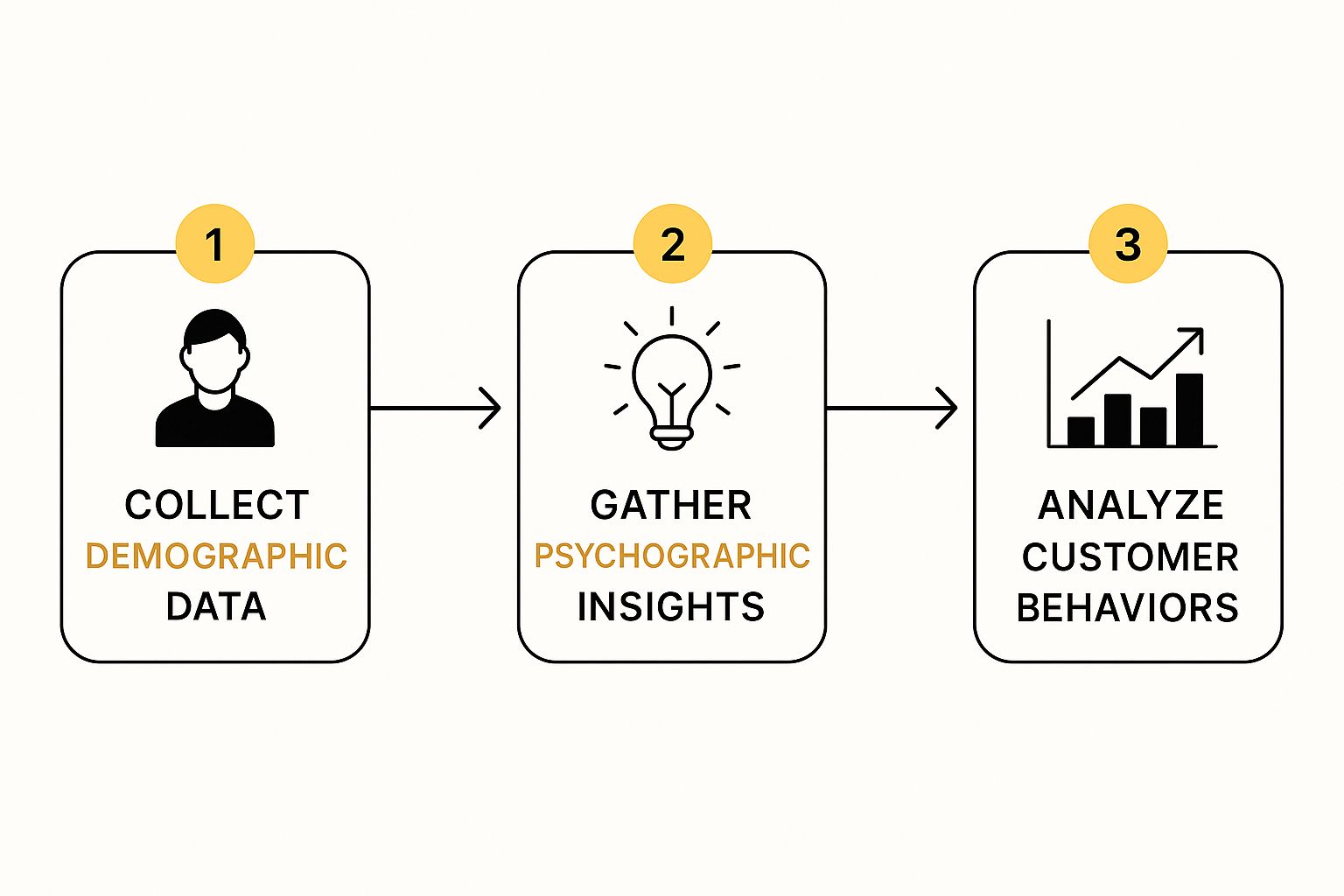If you want to create a buyer persona, you have to move beyond assumptions and build a profile backed by real data. It’s a process of researching your audience, finding patterns in their behavior, and then putting together detailed stories that can guide your entire business. This is how you make sure you're talking to actual people, not just characters you invented.
Why Most Buyer Personas Fail and How to Build Yours Right
Let’s be honest: most buyer personas are dead on arrival. They end up as forgotten PDFs, filled with generic fluff like "Marketing Mary loves yoga and owns a golden retriever." These profiles are useless because they’re built on stereotypes and internal brainstorming sessions, not hard, real-world data.

The biggest mistake people make is treating personas like a creative writing exercise. An effective persona isn't fiction; it’s a strategic tool. Its job is to give you deep, actionable clarity into your customers' worlds so you can make smarter decisions in marketing, sales, and even product development.
Moving from Fiction to Fact
A successful persona is grounded in reality. This means digging into both qualitative and quantitative data to build a realistic picture of your ideal customers. You'll want to pull information from a mix of sources—think market research, customer interviews, surveys, and web analytics—to really understand their demographics, behaviors, and what makes them tick. For a deeper dive, Magnolia CMS has an insightful article on data-driven persona creation.
This data-first approach helps you uncover the little details that guesswork always misses. Instead of just guessing, you actually discover:
- Deep-Seated Motivations: What truly drives their decisions? Is it a promotion at work, saving time on tedious tasks, or just reducing personal stress?
- Daily Frustrations: What are the recurring obstacles they face in their professional or personal lives? What’s the pebble in their shoe?
- Buying Triggers: What specific event or challenge makes them start looking for a solution like yours in the first place?
- Information Sources: Where do they go for advice? Do they trust industry blogs, read peer reviews, or follow influencers on social media?
A great buyer persona tells you more than what a customer does—it tells you why. It captures their anxieties, their ambitions, and the specific language they use to describe their problems.
The True Purpose of a Persona
Ultimately, the goal is to create a tool your entire team will actually use. When a salesperson understands a prospect's core frustrations, they can tailor their pitch to solve a real problem. When a marketer knows which channels their audience trusts, their campaigns become way more efficient.
To get you started, here's a quick roadmap for the process.
Quick Guide to Creating Effective Buyer Personas
This table outlines the essential stages and key activities for building data-driven buyer personas.
| Stage | Core Activity | Primary Goal |
|---|---|---|
| Research & Data Collection | Conduct interviews, surveys, and analyze analytics data from your CRM and website. | Gather raw qualitative and quantitative data about existing and potential customers. |
| Data Analysis & Pattern ID | Sift through the collected data to find common behaviors, pain points, and motivations. | Identify recurring themes and segment your audience into distinct groups. |
| Persona Drafting | Use a template to create a detailed profile for each key segment, giving them a name and story. | Synthesize your findings into a clear, narrative-driven document. |
| Socialization & Refinement | Share the drafted personas with sales, marketing, and product teams for feedback. | Ensure the personas are accurate, useful, and adopted across the organization. |
| Application & Iteration | Integrate the personas into marketing campaigns, content strategy, and sales processes. | Continuously update the personas as you gather new customer data and insights. |
By following these steps, you build a profile that feels like a real person, not a caricature. This creates empathy and gets everyone in your organization aligned, ensuring the entire team is focused on solving the same customer problems. So forget "Marketing Mary" and her dog—it's time to build a strategic asset that delivers tangible results.
Finding Your Customer's Voice Through Smart Research
A great persona isn't born in a boardroom brainstorming session. It's built on a solid foundation of real customer data. This initial research phase is where you dig up the raw materials—the stories, frustrations, and goals that will breathe life into your persona. To get this right, you have to blend two kinds of information: the what and the why.
Quantitative data gives you the what. This is the hard evidence living in your analytics, CRM, and surveys. It shows you what people are doing at scale—user behavior, popular content, and demographic trends.
Qualitative data uncovers the why. These are the human stories you get from interviews and open-ended feedback, explaining the motivations and feelings behind all those numbers. Nail both, and you’ll build a persona that feels real and actually helps you make smarter decisions.
Tapping into Your Existing Goldmine
Before you even think about looking outside, start with the wealth of information you already have. Your internal data is often the most accurate and easily accessible stuff you can get, providing a fantastic baseline for who your audience really is. This is ground zero for connecting the dots on how to create buyer personas that reflect reality, not wishful thinking.
Your internal treasure trove includes:
- Customer Relationship Management (CRM) Data: Look for patterns. Are there common job titles, company sizes, or industries? Which customer segments have the highest lifetime value or the quickest sales cycle?
- Web Analytics: Get cozy with tools like Google Analytics. Trace the most common paths users take, see what content they actually care about, and figure out which referral sources are sending you the good traffic.
- Sales Team Feedback: Your sales reps are on the front lines every single day. They have unfiltered intel on customer objections, the real triggers for a purchase, and the exact words prospects use to describe their problems.
- Customer Support Logs: Support tickets and chat transcripts are a goldmine for finding common pain points. What issues pop up over and over again? What features are people constantly struggling with?
The most powerful insights often come from synthesizing data across departments. When the sales team's anecdotal evidence about a key pain point is validated by a spike in related support tickets, you know you've found something significant.
The Power of Direct Conversation
Internal data is a great start, but nothing—and I mean nothing—replaces talking to actual human beings. Direct interviews are the single best way to gather the rich, qualitative insights that numbers just can't give you. The goal isn't just to confirm what you think you know; it's to uncover those unexpected "aha" moments.
When you sit down with a customer, you're not just running through a list of questions. You're trying to understand their world. A good interview can reveal their daily workflow, their career goals, and the little frustrations that your product is perfectly positioned to solve.
Pro-Tip: Don't just interview your biggest fans. Some of the most valuable feedback comes from people who recently churned or picked a competitor over you. Understanding why they left gives you a brutally honest look at your weaknesses and where the real opportunities are.
Scaling Your Research with Effective Surveys
Interviews give you depth, but surveys give you breadth. They let you validate the patterns you spotted in your interviews across a much larger audience. But be careful—a poorly designed survey is worse than no survey at all. It just gives you bad data and annoys your customers.
To make a survey people will actually finish:
- Keep It Short and Focused: Seriously. Aim for a completion time of 5-7 minutes. Every question should have a clear purpose tied directly to your persona research.
- Mix Question Types: Use a blend of multiple-choice for the hard data and maybe one or two open-ended questions to capture those little bits of personality and nuance.
- Avoid Leading Questions: Instead of asking, "Don't you agree our new feature is awesome?" try, "How would you describe your experience with our new feature?" Let them tell you.
For a deeper dive into the nitty-gritty of gathering insights and building out detailed profiles, check out this comprehensive guide on how to create buyer personas. It’s a great resource that can offer some fresh perspectives on structuring your research.
Pulling all this information together manually can be a huge lift, but new tech can help. A lot of companies are now using intelligent automation to sift through massive datasets and spot patterns way faster than a human ever could. If you're looking to scale up your data analysis, learning more about AI consulting services can show you how to streamline this whole process and pull out even deeper insights from your research.
Turning Raw Data into Actionable Insights
Okay, you’ve done the hard work of research. Now you're probably staring at a mountain of interview notes, survey responses, analytics reports, and feedback from your sales team. It can feel a little chaotic, but this is where the magic really happens. Your job now is to shift from collecting facts to telling a clear, compelling story about your customers.
Think of yourself as a detective sifting through clues. You’re on the hunt for patterns—the recurring themes, shared frustrations, and common goals that connect different customers. This is how you transform a pile of scattered data points into the solid foundation for your buyer personas.
This process is all about layering different types of information to get a full picture.

As you can see, you start with the basic demographic facts, then layer on the "why" (psychographics) and the "what" (behaviors) to create a truly three-dimensional view of who you're talking to.
From Messy Notes to Clear Themes
One of the best ways I've found to make sense of all the qualitative feedback is a simple technique called affinity mapping. Don't let the name fool you; it's basically just organizing sticky notes. Write down individual insights, memorable quotes, and key observations on separate notes.
Once you have everything down, start grouping them on a wall or whiteboard. You’ll quickly see clusters begin to form around specific topics:
- Recurring Pain Points: Are multiple customers complaining about "clunky reporting" or "wasted time on manual data entry"? That's a huge signal.
- Common Goals: Maybe you notice a bunch of interviewees talking about "getting a promotion" or needing to "prove ROI to their boss." These are the motivations that drive them.
- Frequent Objections: What makes people hesitate? Group the notes about budget concerns, implementation fears, or missing features.
- Shared Characteristics: You can also group customers by more concrete things like their industry, company size, or the other software tools they use.
As you create these groups, give each cluster a name, like "Frustrations with Current Software" or "Q4 Goals." All of a sudden, that wall of messy data starts to tell a clear story and reveals the distinct segments hiding in your audience.
Connecting Behaviors with Motivations
While affinity mapping is fantastic for your interview notes and open-ended feedback, you also need to bring in the hard numbers. This is where you connect what people say they do with what they actually do. For example, your Google Analytics data can show you the exact path a user takes from a blog post to a purchase, highlighting which content is actually driving conversions.
By cross-referencing your data, you'll start to uncover some powerful connections. You might notice, for instance, that people who look at case studies are far more likely to buy. You can dig even deeper into this by exploring some proven data-driven buyer persona strategies.
The real breakthrough comes when you can connect the dots. For instance: "Our interviews told us that mid-level managers are anxious about proving their team's value, and our analytics confirm they spend 2.5x more time on our case studies page than any other segment." Now that’s a powerful, data-backed insight you can build a strategy around.
To get this right, you need to understand the difference between the "what" and the "why." Quantitative data tells you what is happening, while qualitative data tells you why it's happening.
Qualitative vs. Quantitative Data Sources for Personas
A comparison of data collection methods, their benefits, and when to use them for building robust buyer personas.
| Data Type | Examples | Best For Understanding |
|---|---|---|
| Qualitative | Customer Interviews, Open-Ended Survey Questions, Sales Team Feedback, Support Tickets | The "Why" Behind Customer Actions, Motivations, Goals, Frustrations, Emotional Drivers |
| Quantitative | Website Analytics (e.g., Google Analytics), CRM Data, Product Usage Data, Surveys with Scaled Answers | The "What" and "How" of Customer Behavior, Common Paths, Demographics, Key Segments |
Both types of data are essential. Relying on just one gives you an incomplete picture. The best personas are built by weaving together insights from both qualitative and quantitative sources to create a complete and accurate profile.
How Many Personas Do You Really Need?
This is a question I get all the time. The answer isn't some magic number; it's about focus and usability. If you create too many personas, your team will get overwhelmed and end up using none of them. My advice? Start small.
Look at the data clusters you created. Do you see two or three truly distinct groups with different goals, pain points, and behaviors? For example, you might end up with:
- "Strategic Sarah," a C-level executive who only cares about long-term ROI and big-picture business growth.
- "Manager Mike," a department head obsessed with team productivity and hitting his quarterly targets.
- "Practitioner Paula," an end-user on the front lines who just wants a tool that’s easy to use and saves her time.
If their needs and buying journeys are different enough to justify separate messaging, content, and product features, they each deserve their own persona. If the differences are minor, you can often roll them into one primary persona with a few secondary notes.
The golden rule is to create only as many personas as you can actually use to make smarter decisions. Focus on the customer profiles that will have the biggest impact on your business first. You can always add more later.
Bringing Your Buyer Persona to Life
You've made it through the data jungle. After wading through spreadsheets, interview notes, and analytics reports, it's finally time to pull all those insights together into something that feels, well, human. This is where the magic happens—where data gets a face and a story.
A great persona profile isn't just a dry summary of facts. It’s a narrative that builds empathy and gives your entire team a shared picture of who they’re really working for.

The goal here is simple: create a powerful, one-page reference tool that anyone in the company can look at and just get. Let’s walk through how to turn that raw research into a character your team will actually remember.
Start with a Name and a Face
First things first, give your persona a name and grab a stock photo. It might feel like a fluffy detail, but it’s a huge psychological shortcut. It’s just so much easier for your team to rally around "Strategic Sarah" than it is to talk about "Segment A, 35-45, B2B Manager."
I’m a big fan of alliterative names because they’re memorable and can hint at their role (like "Founder Frank" or "Developer Dave"). For the photo, find a high-quality stock image that genuinely reflects the professional vibe and demographics you found in your research.
Building the Persona Profile, Piece by Piece
With a name and face in place, you can start fleshing out the rest of the document. Think of each section as another layer of the story, adding depth and context.
Here's a simple structure that covers all the critical stuff:
- Demographics: This is your foundation. Include their age, income level, location, and education. Keep it lean—only include the data points that actually impact how they buy.
- Job & Seniority: What’s their title? What are their main responsibilities? Getting a handle on their professional life is absolutely critical, especially in B2B.
- A Day in Their Life: This is where you really bring them to life. Write a short narrative describing a typical day, weaving in the tools they use and the challenges they run into. This context is gold for your product and marketing teams.
For example, a "Day in the Life" for "Manager Mike" might start with him sifting through performance reports before his morning stand-up. That single detail immediately highlights his need for better data visualization, making the persona far more relatable than a boring list of facts.
A well-written persona feels less like a sterile data sheet and more like a character bio for a movie. It should be compelling enough that your team remembers their story long after they’ve closed the document.
Getting to the "Why": Motivations and Frustrations
This section is the heart of your persona. While demographics tell you who they are, this part explains why they do what they do. You're digging into the internal and external drivers that are crucial for crafting messaging that actually connects.
Goals: What Drives Them?
List out their primary and secondary goals. What are they trying to accomplish at work or in their personal life? These are the positive outcomes they're chasing.
- Primary Goal: "Secure a promotion to Director of Marketing within two years."
- Secondary Goal: "Reduce time spent on manual reporting to focus on strategy."
Challenges: What's Blocking Them?
Next, map out their biggest pain points. What’s getting in the way of them hitting those goals? These challenges are the problems your product or service needs to solve.
- Primary Challenge: "Struggling to prove the ROI of marketing campaigns to the C-suite."
- Secondary Challenge: "The current software is clunky and requires too much manual work from my team."
Add Some Punch with Real Quotes
One of the best ways to make a persona feel real is to pull in a few direct quotes from your customer interviews. Sprinkling these verbatim comments throughout the profile adds a layer of authenticity that you just can't fake.
A quote like, "I spend at least five hours a week just copy-pasting data between spreadsheets. It’s the most soul-crushing part of my job," hits so much harder than a bullet point that says "Wastes time on manual tasks." It injects real, human emotion into the document.
Tie It All Together with a Killer Bio
Finally, pull everything together with a short, punchy bio. This little paragraph should read like a quick introduction, summarizing the persona’s story, role, main challenges, and core motivations in just a couple of sentences.
Here’s an example for "Strategic Sarah":
"Sarah is a results-driven VP of Operations at a mid-sized tech company. She is laser-focused on improving efficiency and proving profitability but is constantly bogged down by disconnected systems and a lack of clear data. She’s actively searching for a solution that can give her a single source of truth to make faster, more confident business decisions."
This summary is the perfect "at-a-glance" overview for anyone who needs a quick reminder. By combining a memorable name, a relatable photo, and real customer language, you create a simple yet incredibly powerful tool that gets your entire company on the same page. This is how you make buyer personas that people actually use.
Weaving Personas into Your Business Strategy
Look, creating a buyer persona isn't the finish line—it’s the starting gun. A persona that just sits in a shared drive gathering digital dust is a massive missed opportunity. Their real power gets unlocked when they become active, breathing documents that guide decisions across your entire company, from marketing and sales all the way to product development.
This is how you turn a well-researched profile into a strategic asset. It aligns your whole team around the most important person: the customer. When every department speaks the same language and works from the same playbook, you create a seamless customer experience that actually works.

Fueling a Smarter Marketing Engine
For your marketing team, personas are the ultimate cheat sheet. They completely eliminate the guesswork. This allows for sharper, more effective campaigns that connect with people on a much deeper level. Instead of shouting into the void, you can have a direct, meaningful conversation with your ideal customer.
This is where all that research starts to pay off. The data shows that websites tailored with personas become 2 to 5 times more effective for the users they’re targeting. And personalized emails? Using personas can double your open rates and boost click-throughs by 5x. It works because every single piece of communication is built on a foundation of genuine customer understanding.
Here’s how personas can totally transform your marketing:
- Content That Actually Connects: Knowing "Strategic Sarah" is obsessed with ROI helps you create blog posts and case studies that speak directly to her primary goal. You stop creating content for everyone and start creating it for someone.
- Precision Channel Selection: If your research shows "Practitioner Paula" spends her time in niche LinkedIn groups, that’s exactly where you should invest your social media budget. Personas tell you where your audience actually lives online.
- Messaging That Lands: You can lift the exact words and phrases from your customer interviews and drop them right into your ad copy, landing pages, and email subject lines. This ensures your message hits home every time.
Empowering Sales with Actionable Insight
Your sales team is on the front line, and personas are their secret weapon for building rapport and closing deals. A well-defined persona gives them the context they need to move beyond a generic product pitch and have a real conversation about solving real problems.
A salesperson armed with a persona doesn't just sell a product; they sell a solution to a specific, well-understood challenge. They can see objections coming from a mile away and tailor their approach to what truly matters to the prospect.
Imagine a sales rep getting ready for a call with a "Manager Mike." They already know his key challenge is team productivity and his biggest fear is a messy, disruptive implementation process.
This insight lets them:
- Frame the Conversation: They can open the call by focusing on efficiency gains instead of rattling off a list of technical features.
- Anticipate Objections: They can proactively address implementation concerns with a clear, step-by-step plan before Mike even brings it up.
- Build Genuine Rapport: They can connect on a deeper level by showing they truly understand the pressures of his specific role.
Guiding Product Development and Innovation
This might be the most overlooked benefit of personas: their impact on what you actually build. It’s so easy for product teams to get stuck in an echo chamber, prioritizing features they think are important. Personas break that cycle by bringing the customer's voice directly into the product roadmap.
When your development team understands "Practitioner Paula’s" daily frustrations with clunky software, they’re not just building another feature—they’re solving her biggest headache. This customer-centric approach leads to a much better product and happier users. In fact, a strong product-market fit often starts with solid https://upnorthmedia.co/services/seo-marketing that attracts the right initial users, whose feedback then refines the product.
By integrating personas, your product team can confidently answer critical questions like:
- Which new feature should we prioritize next? Simple. Focus on the one that solves the biggest pain point for your primary persona.
- How should this feature work? Design it based on the technical savvy and daily workflow of the end-user persona.
- Is this new feature request valid? Check if it aligns with the core goals and needs of any of your key personas. If not, it's probably noise.
When personas become a core part of how you operate, they create a powerful feedback loop. Marketing attracts the right people, sales understands their needs, and the product team builds solutions they genuinely love. This alignment is the real key to sustainable, customer-driven growth.
Common Questions About Building Buyer Personas
Even with a solid plan, a few questions always seem to come up when a team dives into creating buyer personas for the first time. I've been there. Getting clarity on these points from the start can be the difference between a persona that gathers dust and one that actually drives strategy.
Let's walk through some of the most common hurdles I see and how to clear them.
How Many Buyer Personas Should We Create?
This is always the first question, and my answer is almost always the same: start with fewer than you think you need. It's so much better to have one or two incredibly sharp, well-researched personas that your team knows inside and out than to have ten shallow ones that just create noise.
For most businesses, 1-3 key personas is the perfect starting point. Think about it: which customer segments bring in the most revenue? Who has the highest growth potential? Focus your energy there first.
You can always build more later on. Quality over quantity is the name of the game here.
How Often Should We Update Our Personas?
Buyer personas are not a "set it and forget it" project. Your customers change, markets shift, and technology evolves. To stay useful, your personas have to keep up.
As a general rule, I recommend a formal review and refresh at least once a year. That said, you should be ready to jump in sooner if you see a major shift, like:
- You've launched a totally new product or service.
- You're breaking into a new market or industry.
- Your analytics are showing a significant change in customer behavior.
Treat your personas as living documents. I find that a quick quarterly check-in with the sales and support teams is a great way to catch early signals that a persona's goals or pain points might be changing.
What if We Have Both B2B and B2C Customers?
If you sell to both businesses and individual consumers, you absolutely need separate sets of personas. Don't even try to mash them together—it never works. Their motivations, buying cycles, and how they make decisions are just worlds apart.
A B2B persona will be all about professional goals, job titles, and company-wide challenges. For B2C, you'll be digging into personal aspirations, lifestyle choices, and individual frustrations.
Can We Create Personas Without a Big Budget?
Yes, you definitely can. While a big budget for fancy surveys is nice to have, it's far from necessary. Honestly, some of the best insights come from low-cost (or even free) methods.
Start by interviewing five of your best customers. That conversation alone will give you a mountain of valuable information. Then, dive into your website analytics, read online reviews in your industry, and have real, in-depth conversations with your sales team. This groundwork is more than enough to build a powerful first draft.
As your personas start to take shape, you'll see how they naturally connect to the bigger picture of creating a great customer journey. To dig deeper on that, check out our guide on how to improve customer experience. It provides some great context for putting your new persona insights into action.
At Up North Media, we specialize in turning customer data into actionable growth strategies. If you're ready to build a digital presence that truly connects with your ideal audience, let's talk. Contact us today for a free consultation.
